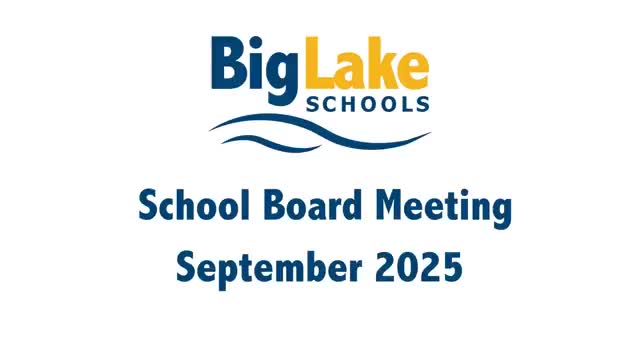Big Lake outlines district goals with literacy focus, supports for struggling students
October 03, 2025 | BIG LAKE PUBLIC SCHOOL DISTRICT, School Boards, Minnesota
This article was created by AI summarizing key points discussed. AI makes mistakes, so for full details and context, please refer to the video of the full meeting. Please report any errors so we can fix them. Report an error »

District leaders presented the Big Lake Public School District’s district-level goals, highlighting literacy, staff support and family engagement as priorities tied to the district’s strategic plan through 2027.
Presenters said the goals align with state expectations—particularly the READ Act—and the district’s strategic plan, and include specific targets such as raising the share of students reading at grade level and keeping 95% of students who are low-risk in the fall at low risk in the spring, as measured by FastBridge and other assessments. The district also described an MTSS (Multi-Tiered System of Supports) framework and ongoing literacy professional development.
Staff told the board they will return in November with preliminary data for the 2024–25 school year and to propose building-level goals that funnel from the district goals. The presentation named Liberty Elementary and Independence Elementary as examples of buildings aligning student, staff and family engagement goals to district priorities.
Graduation and credit-recovery efforts
District staff described multiple interventions to support on-time graduation. The high school now has three counselors—two academic counselors and one behavior-intervention-focused academic counselor—charged with early credit monitoring and intervention. The district has launched a night-school program using online coursework (staff cited Edgenuity) to allow students to earn additional credits beyond the regular school day. Staff also said they offer summer targeted services and personalized supports for students falling behind.
Board discussion included questions about teacher outreach and parent contact strategies; presenters said elementary teachers use Seesaw and phone-call outreach, and the district provides scripts to teachers—particularly newer teachers—to support family contact and engagement.
Ending
District presenters said they would provide a deeper data update in November and work with buildings to refine goals once state assessment and graduation data arrive.
Presenters said the goals align with state expectations—particularly the READ Act—and the district’s strategic plan, and include specific targets such as raising the share of students reading at grade level and keeping 95% of students who are low-risk in the fall at low risk in the spring, as measured by FastBridge and other assessments. The district also described an MTSS (Multi-Tiered System of Supports) framework and ongoing literacy professional development.
Staff told the board they will return in November with preliminary data for the 2024–25 school year and to propose building-level goals that funnel from the district goals. The presentation named Liberty Elementary and Independence Elementary as examples of buildings aligning student, staff and family engagement goals to district priorities.
Graduation and credit-recovery efforts
District staff described multiple interventions to support on-time graduation. The high school now has three counselors—two academic counselors and one behavior-intervention-focused academic counselor—charged with early credit monitoring and intervention. The district has launched a night-school program using online coursework (staff cited Edgenuity) to allow students to earn additional credits beyond the regular school day. Staff also said they offer summer targeted services and personalized supports for students falling behind.
Board discussion included questions about teacher outreach and parent contact strategies; presenters said elementary teachers use Seesaw and phone-call outreach, and the district provides scripts to teachers—particularly newer teachers—to support family contact and engagement.
Ending
District presenters said they would provide a deeper data update in November and work with buildings to refine goals once state assessment and graduation data arrive.
View full meeting
This article is based on a recent meeting—watch the full video and explore the complete transcript for deeper insights into the discussion.
View full meeting
